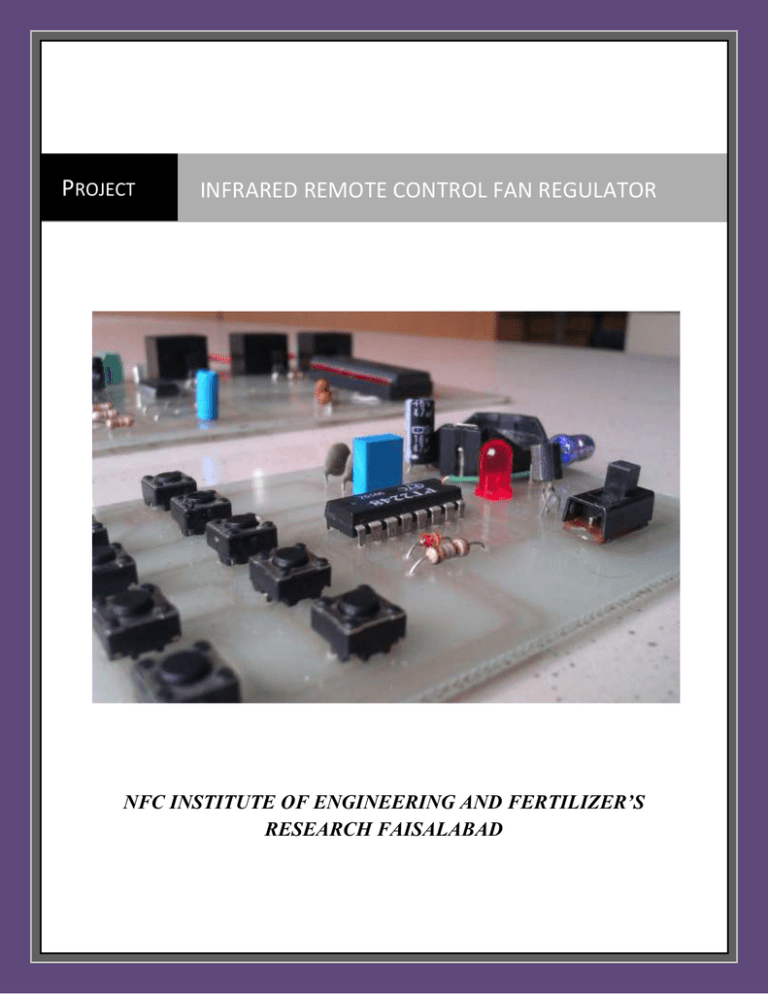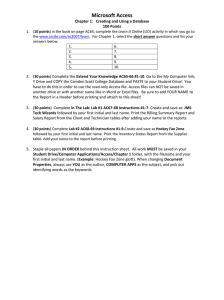infrared remote control fan regulator
advertisement

PROJECT
INFRARED REMOTE CONTROL FAN REGULATOR
NFC INSTITUTE OF ENGINEERING AND FERTILIZER’S
RESEARCH FAISALABAD
www.paksc.org
Group members
Sohaib ud Din Ahmed
10-EL-41
Muhammad Rizwan
10-EL-89
Awais Karim
10-EL-07
Ali Aoun Bukhari
10-EL-29
Infrared remote control fan regulator
www.paksc.org
ABSTRACT
This project presented a easy design and execution of a remote controlled fan
regulator. It enables the user to control a fan regulator from around 5 meters away.
Button on the remote can be used for controlling speed of the fan. There are three
functional buttons at the remote; they are used for three different speeds. When a
button was pressed on the remote control, the infrared light emitting diode then
transmits the signal to the infrared sensor. The fan then produced an output in
accordance to the action commanded by the remote control. The circuit was used
to control the speed of the bracket fan for three levels. The system was broken
down into simpler functional blocks namely; infra-red transmitter (remote control),
infra-red receiver, Micro controller, relays, and fan. Theories of design,
construction, and equations were clearly expressed in this write-up which clarified
how materials were used for the entire project.
ACKNOWLEGDEMENT
We would like to express our profound gratitude to all who contributed to the
success of this project, especially to Mr.Awais Anjum for their constant guidance,
encouragement, advice and support.
Most of all, our greatest appreciation goes to the Almighty Allah for giving us life,
strength and encouragement, right from the beginning and to the end of this
project.
www.paksc.org
INTRODUCTION
Remote control facilitates the operation of fan regulators around the home or office
from a distance. It provides a system that is simple to understand and also to
operate, a system that would be reliable and easy to maintain and durable
irrespective of its usage. It adds more comfort to everyday living by removing the
inconvenience of having to move around to operate a fan regulator.
The first remote control, called “lazy bones” was developed in 1950 by Zenith
Electronics Corporation (then known as Zenith Radio Corporation). The device
was developed quickly, and it was called “Zenith space command”, the remote
went into production in the fall of 1956, becoming the first practical wireless
remote control device.
Today, remote control is a standard on electronic products, including VCRs, cable
and satellite boxes, digital video disc players and home audio players. In the year
2000, more than 99 percent of all TV set and 100 percent of all VCR and DVD
players sold are equipped with remote controls.
The average individual these days probably picks up a remote control at least once
or twice a day.
Basically, a remote control works in the following manner, a button is pressed.
This completes a specific connection which produces a code line signal specific to
that button. The transistor amplifies the signal and sends it to the LED which
translates the signal into infrared light. The sensor on the appliance detects the
infrared light and reacts appropriately.
The remote control’s function is to wait for the user to press a key and then
translate that into infrared light signals that are received by the receiving appliance.
The aim of this work is to design and construct a remote control for a fan regulator.
The remote control device sends an infra-red beam, which is received by the infrared sensor on the regulator and the speed of the fan is increased or decreased.
Problem Statement
The remote control technology which is basically controlling an object from a
distance provides flexible, effective and accident free way of controlling
appliances or systems. It is inconvenient having to move around to change the
setting of a fan regulator in accordance to the temperature of the room, hence, the
need for a remote control technology.
www.paksc.org
Objective
The purpose of this project is to:
Design a remote control that is portable in size and a regulator (receiver) that
responds only to the infra-red signal transmitted by the remote control. Control the
speed of a bracket fan in three levels.
Significance of Study
This work will enable people to operate their fans from a distance. For example,
when feeling tired or lazy to get up from their couches and also whilst in bed one
can easily reach out his/her remote to control or operate the fan within a specific
distance. In other words, it will add more comfort to everyday living, as the
inconvenience of having to move around to operate a fan regulator is removed. It
will also help the aged and the disabled to control their fan without stress.
Principles of Infrared Operation
Since infrared (IR) remote controls use light, they require line of sight to operate
the destination device. The signal can, however, be reflected by mirrors, just like
any other light source. If operation is required where no line of sight is possible,
for instance when controlling equipment in another room or installed in a cabinet,
many brands of IR extenders are available for this on the market. Most of these
have an IR receiver, picking up the IR signal and relaying it via radio waves to the
remote part, which has an IR transmitter mimicking the original IR control.
Infrared receivers also tend to have a more or less limited operating angle, which
mainly depends on the optical characteristics of the phototransistor. However, it is
easy to increase the operating angle using a matte transparent object in front of the
receiver.
Advantages of this Project
This circuit is simple to use and efficient.
It is small in size.
It is cheap and hence very economical.
It can be assembled with ease.
www.paksc.org
METHODOLOGY
Firstly we design a remote control, by using infrared transmitting IC PT2248. The
circuit diagram and parts list I given below.
Parts List
PT 2248
3 volt battery
Switch
47uF 16volts
Transistor (C557)
Infrared LED
Led
Resistance (180 ohms)
Crystals (455 KHz)
Diode (1N4148)
Capacitors (120p)
Touch buttons (10)
PCB design of the remote
www.paksc.org
Final diagram of our remote control
We make a receiver circuit of this remote system and attach it to a bracket fan
winding. The circuit diagram of receiver and parts list is given below
www.paksc.org
Parts list
Regulator 7805
Diode 1N4007
Battery 12 volts
Capacitor 47uF 16 volts (3)
Infrared receiver
Green Led
Resistances 3.3K (as require)
Resistance 39K (2)
Capacitor 102p
Transistor C 3198
Resistance 47 ohm
Circuit diagram of controller circuit
www.paksc.org
Parts list
89C51
BC 547 (3)
Diode 1n4007 (3)
Relay 12 Volt (3)
Crystal 8Mhz
Capacitors 33 pF
Capacitor 10uF 25 volts
Resistance 10K
Fan
104 polar capacitor (4)
www.paksc.org
Final PCB design
Final representation of the project
www.paksc.org
Coding for ATMEL 89C51
#include <AT89X51.h>
void main(void)
{
P0=0X00;
P1=0X00;
www.paksc.org
P2=0x00;
P3=0X07;
while(1)
{
if(P3_0==1)
{
P1=0;
P1_0=1;
}
else if(P3_1==1)
{
P1=0;
P1_1=1;
}
else if(P3_2==1)
{
P1=0;
P1_2=1;
}
else if(P3_3==1)
{
P1=0;
}
}
}
www.paksc.org
Conclusion
With the knowledge of new techniques in ‘Electronics’ we are able to make our
life more comfortable. One such application of electronics is used in this project.
Remote controlled Fan Regulator is one of the applications of electronics to
increase the facilities of life. It gives one the ability to control the speed of his/her
fan from a distance within the specification.
The same circuit finds its use in many more applications. By this the intensity of
light can be controlled using a remote. The intensity of light can be controlled in
five levels from off position to maximum intensity possible.
So it finds, it use as a night lamp by keeping the intensity of lamp in low level. The
circuit also finds its use for switching ON and OFF any electronic circuitry. So it is
very useful or a real help to old age and physically challenged people, since they
can control the speed from the place where they are sitting.
We hope this project serves something good in our homes.
Recommendation
It is our wish for someone to take up this project and improve upon it. Especially,
the packaging of the remote control which was not properly done due to lack of
materials. It also requires very little or no maintenance, that is why its use should
be encouraged in our homes.
This innovation can be a success only if people are made aware about its
advantages and how user-friendly it is.




